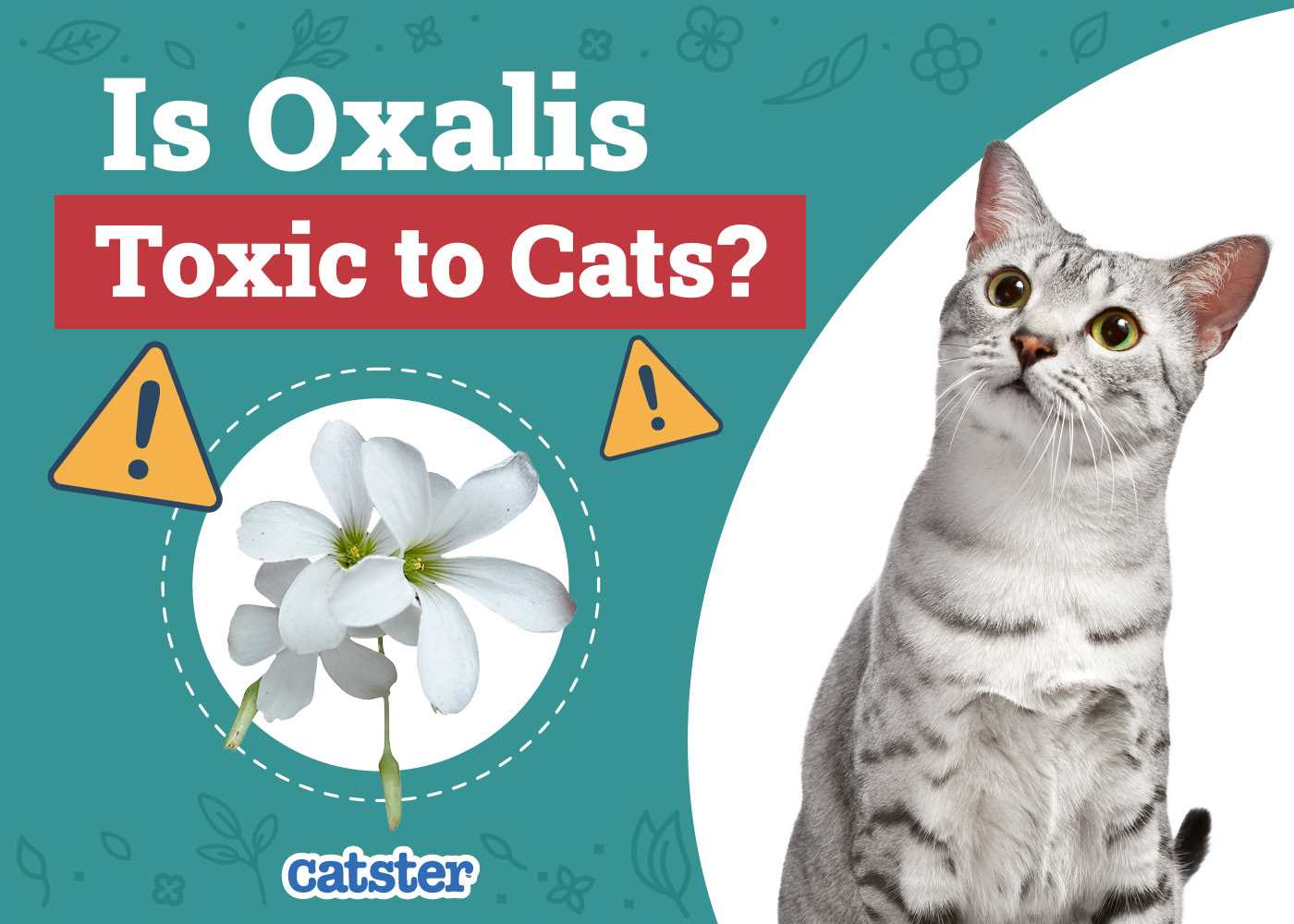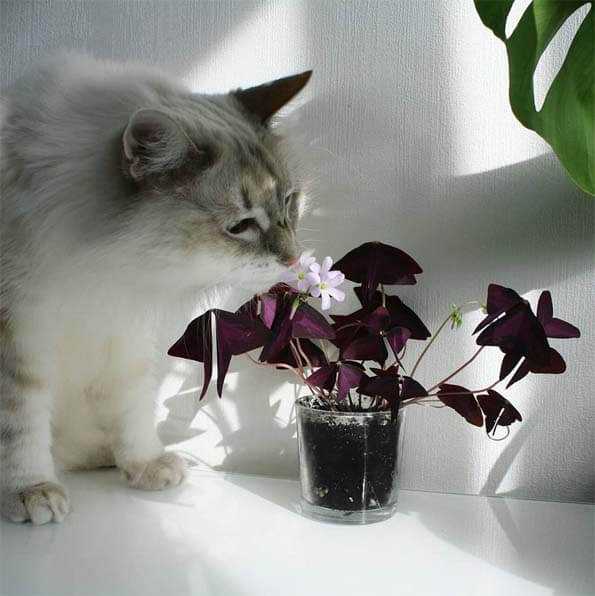

Yes, this particular plant can pose risks to our furry companions. It contains substances that may cause gastrointestinal upset if consumed in significant amounts. Symptoms like vomiting, diarrhea, or drooling can occur, so it’s wise to keep it out of reach.
If you suspect your pet has nibbled on it, monitor for any unusual behavior or signs of distress. Consulting a veterinarian for tailored advice is always a good strategy. Prevention is key; consider alternative greenery that is safe for pets.
Creating a safe environment for your four-legged roommate involves knowing which plants to avoid. Enjoy your gardening, but always prioritize your pet’s well-being.
Is Oxalis Toxic to Felines?
Yes, this plant can be harmful to us furry friends. It contains compounds that may lead to gastrointestinal upset, including vomiting and diarrhea if ingested.
Symptoms to Watch For

If you suspect that I or another feline has nibbled on this plant, look out for signs like excessive drooling, abdominal pain, or lethargy. Quick action is crucial, so notifying a vet is wise if these symptoms appear.
Prevention Tips

To keep your environment safe, consider removing this plant from your home or ensuring it’s placed out of reach. Offering alternative safe plants can satisfy our curiosity without posing risks.
Identifying the Types of Oxalis Plants

When exploring the different varieties of these plants, look out for the most common types. The Oxalis triangularis, known for its striking purple leaves, is often referred to as the purple shamrock. It’s a favorite among plant enthusiasts due to its unique appearance and easy care requirements.
Another notable variety is the Oxalis deppei, also called the Mexican shamrock. It features cheerful yellow flowers and is often used for ground cover. Its resilience makes it a popular choice for gardens and indoor settings alike.
The Oxalis acetosella, or wood sorrel, has a more delicate look, with heart-shaped leaves and white or pink flowers. This type thrives in cooler climates and can often be found in shaded areas, making it a great addition to woodland gardens.
Always ensure you properly identify these plants before introducing them into your home. If you’re curious about other pet-friendly options, you can check out whether string beans are safe for your furry friends. It’s also wise to stay informed about the best roundworm dewormer for any unexpected health issues that may arise.
Symptoms of Oxalis Poisoning in Cats
When I accidentally nibbled on a leaf of that green troublemaker, I noticed a few signs that worried me. If you think your feline friend has had a taste, look out for symptoms like:
Vomiting: This was the first thing that happened to me. It was uncomfortable, and I couldn’t keep my food down.
Diarrhea: My tummy was not happy, leading to some messy situations. If your companion is having similar issues, it might be time to act.
Lethargy: I felt so tired and just wanted to lounge around. If your buddy seems unusually sleepy or disinterested, pay attention.
Loss of appetite: When I wasn’t feeling well, I didn’t want to eat. If your pet is skipping meals, this could be a red flag.
Excessive drooling: I found myself drooling more than usual, which was quite odd. Keep an eye out for this unusual behavior.
Abdominal pain: I could feel some discomfort in my belly. If your furry friend is showing signs of pain or sensitivity around their stomach, it’s a cause for concern.
Keep these signs in mind, and if you notice any of them, it’s best to contact a veterinarian right away. Quick action could make all the difference for your furry pal.
Immediate Steps if Your Cat Ingests Oxalis
If I accidentally eat any part of the clover-like plant, here’s what you should do right away:
- Stay calm and check my mouth. Look for any visible plant material.
- Rinse my mouth gently with water, if possible, to remove any remaining bits.
- Contact your veterinarian immediately. Provide them with details about the incident, including how much I might have eaten.
- Do not induce vomiting unless instructed by a vet, as this may cause more harm.
- Monitor me closely for any signs of distress or unusual behavior.
Keep these items on hand to help:
- Emergency contact information for the vet.
- List of plants I’ve had access to recently.
- A record of any symptoms I may show.
Being prepared means you can act quickly if I munch on something I shouldn’t!
Video:
Yes, this particular plant can pose risks to our furry companions. It contains substances that may cause gastrointestinal upset if consumed in significant amounts. Symptoms like vomiting, diarrhea, or drooling can occur, so it’s wise to keep it out of reach.
If you suspect your pet has nibbled on it, monitor for any unusual behavior or signs of distress. Consulting a veterinarian for tailored advice is always a good strategy. Prevention is key; consider alternative greenery that is safe for pets.
Creating a safe environment for your four-legged roommate involves knowing which plants to avoid. Enjoy your gardening, but always prioritize your pet’s well-being.
Is Oxalis Toxic to Felines?
Yes, this plant can be harmful to us furry friends. It contains compounds that may lead to gastrointestinal upset, including vomiting and diarrhea if ingested.
Symptoms to Watch For

If you suspect that I or another feline has nibbled on this plant, look out for signs like excessive drooling, abdominal pain, or lethargy. Quick action is crucial, so notifying a vet is wise if these symptoms appear.
Prevention Tips

To keep your environment safe, consider removing this plant from your home or ensuring it’s placed out of reach. Offering alternative safe plants can satisfy our curiosity without posing risks.
Identifying the Types of Oxalis Plants

When exploring the different varieties of these plants, look out for the most common types. The Oxalis triangularis, known for its striking purple leaves, is often referred to as the purple shamrock. It’s a favorite among plant enthusiasts due to its unique appearance and easy care requirements.
Another notable variety is the Oxalis deppei, also called the Mexican shamrock. It features cheerful yellow flowers and is often used for ground cover. Its resilience makes it a popular choice for gardens and indoor settings alike.
The Oxalis acetosella, or wood sorrel, has a more delicate look, with heart-shaped leaves and white or pink flowers. This type thrives in cooler climates and can often be found in shaded areas, making it a great addition to woodland gardens.
Always ensure you properly identify these plants before introducing them into your home. If you’re curious about other pet-friendly options, you can check out whether string beans are safe for your furry friends. It’s also wise to stay informed about the best roundworm dewormer for any unexpected health issues that may arise.
Symptoms of Oxalis Poisoning in Cats
When I accidentally nibbled on a leaf of that green troublemaker, I noticed a few signs that worried me. If you think your feline friend has had a taste, look out for symptoms like:
Vomiting: This was the first thing that happened to me. It was uncomfortable, and I couldn’t keep my food down.
Diarrhea: My tummy was not happy, leading to some messy situations. If your companion is having similar issues, it might be time to act.
Lethargy: I felt so tired and just wanted to lounge around. If your buddy seems unusually sleepy or disinterested, pay attention.
Loss of appetite: When I wasn’t feeling well, I didn’t want to eat. If your pet is skipping meals, this could be a red flag.
Excessive drooling: I found myself drooling more than usual, which was quite odd. Keep an eye out for this unusual behavior.
Abdominal pain: I could feel some discomfort in my belly. If your furry friend is showing signs of pain or sensitivity around their stomach, it’s a cause for concern.
Keep these signs in mind, and if you notice any of them, it’s best to contact a veterinarian right away. Quick action could make all the difference for your furry pal.
Immediate Steps if Your Cat Ingests Oxalis
If I accidentally eat any part of the clover-like plant, here’s what you should do right away:
- Stay calm and check my mouth. Look for any visible plant material.
- Rinse my mouth gently with water, if possible, to remove any remaining bits.
- Contact your veterinarian immediately. Provide them with details about the incident, including how much I might have eaten.
- Do not induce vomiting unless instructed by a vet, as this may cause more harm.
- Monitor me closely for any signs of distress or unusual behavior.
Keep these items on hand to help:
- Emergency contact information for the vet.
- List of plants I’ve had access to recently.
- A record of any symptoms I may show.
Being prepared means you can act quickly if I munch on something I shouldn’t!
Video:
Yes, this particular plant can pose risks to our furry companions. It contains substances that may cause gastrointestinal upset if consumed in significant amounts. Symptoms like vomiting, diarrhea, or drooling can occur, so it’s wise to keep it out of reach.
If you suspect your pet has nibbled on it, monitor for any unusual behavior or signs of distress. Consulting a veterinarian for tailored advice is always a good strategy. Prevention is key; consider alternative greenery that is safe for pets.
Creating a safe environment for your four-legged roommate involves knowing which plants to avoid. Enjoy your gardening, but always prioritize your pet’s well-being.
Is Oxalis Toxic to Felines?
Yes, this plant can be harmful to us furry friends. It contains compounds that may lead to gastrointestinal upset, including vomiting and diarrhea if ingested.
Symptoms to Watch For

If you suspect that I or another feline has nibbled on this plant, look out for signs like excessive drooling, abdominal pain, or lethargy. Quick action is crucial, so notifying a vet is wise if these symptoms appear.
Prevention Tips

To keep your environment safe, consider removing this plant from your home or ensuring it’s placed out of reach. Offering alternative safe plants can satisfy our curiosity without posing risks.
Identifying the Types of Oxalis Plants

When exploring the different varieties of these plants, look out for the most common types. The Oxalis triangularis, known for its striking purple leaves, is often referred to as the purple shamrock. It’s a favorite among plant enthusiasts due to its unique appearance and easy care requirements.
Another notable variety is the Oxalis deppei, also called the Mexican shamrock. It features cheerful yellow flowers and is often used for ground cover. Its resilience makes it a popular choice for gardens and indoor settings alike.
The Oxalis acetosella, or wood sorrel, has a more delicate look, with heart-shaped leaves and white or pink flowers. This type thrives in cooler climates and can often be found in shaded areas, making it a great addition to woodland gardens.
Always ensure you properly identify these plants before introducing them into your home. If you’re curious about other pet-friendly options, you can check out whether string beans are safe for your furry friends. It’s also wise to stay informed about the best roundworm dewormer for any unexpected health issues that may arise.
Symptoms of Oxalis Poisoning in Cats
When I accidentally nibbled on a leaf of that green troublemaker, I noticed a few signs that worried me. If you think your feline friend has had a taste, look out for symptoms like:
Vomiting: This was the first thing that happened to me. It was uncomfortable, and I couldn’t keep my food down.
Diarrhea: My tummy was not happy, leading to some messy situations. If your companion is having similar issues, it might be time to act.
Lethargy: I felt so tired and just wanted to lounge around. If your buddy seems unusually sleepy or disinterested, pay attention.
Loss of appetite: When I wasn’t feeling well, I didn’t want to eat. If your pet is skipping meals, this could be a red flag.
Excessive drooling: I found myself drooling more than usual, which was quite odd. Keep an eye out for this unusual behavior.
Abdominal pain: I could feel some discomfort in my belly. If your furry friend is showing signs of pain or sensitivity around their stomach, it’s a cause for concern.
Keep these signs in mind, and if you notice any of them, it’s best to contact a veterinarian right away. Quick action could make all the difference for your furry pal.
Immediate Steps if Your Cat Ingests Oxalis
If I accidentally eat any part of the clover-like plant, here’s what you should do right away:
- Stay calm and check my mouth. Look for any visible plant material.
- Rinse my mouth gently with water, if possible, to remove any remaining bits.
- Contact your veterinarian immediately. Provide them with details about the incident, including how much I might have eaten.
- Do not induce vomiting unless instructed by a vet, as this may cause more harm.
- Monitor me closely for any signs of distress or unusual behavior.
Keep these items on hand to help:
- Emergency contact information for the vet.
- List of plants I’ve had access to recently.
- A record of any symptoms I may show.
Being prepared means you can act quickly if I munch on something I shouldn’t!








